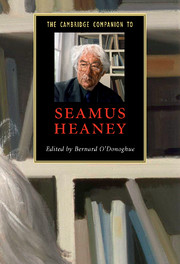Book contents
- Frontmatter
- 1 Introduction
- 2 Seamus Heaney’s Working Titles
- 3 The Context of Heaney’s Reception
- 4 Heaney in Public
- 5 Heaney and the Feminine
- 6 Heaney and Eastern Europe
- 7 Heaney’s Classics and the Bucolic
- 8 Professing Poetry
- 9 Heaney and the Irish Poetic Tradition
- 10 Irish Influence and Confluence in Heaney’s Poetry
- 11 Heaney and Yeats
- 12 Heaney’s Wordsworth and the Poetics of Displacement
- 13 Heaney, Beowulf and the Medieval Literature of the North
- 14 Crediting Marvels
- Guide to Further Reading
- Index
7 - Heaney’s Classics and the Bucolic
Published online by Cambridge University Press: 28 March 2009
- Frontmatter
- 1 Introduction
- 2 Seamus Heaney’s Working Titles
- 3 The Context of Heaney’s Reception
- 4 Heaney in Public
- 5 Heaney and the Feminine
- 6 Heaney and Eastern Europe
- 7 Heaney’s Classics and the Bucolic
- 8 Professing Poetry
- 9 Heaney and the Irish Poetic Tradition
- 10 Irish Influence and Confluence in Heaney’s Poetry
- 11 Heaney and Yeats
- 12 Heaney’s Wordsworth and the Poetics of Displacement
- 13 Heaney, Beowulf and the Medieval Literature of the North
- 14 Crediting Marvels
- Guide to Further Reading
- Index
Summary
In the best recent book on Irish literature and Greek tragedy, Marianne McDonald observes that in many ways Ireland ‘is constructing its identity through the representations offered by Greek tragedy’. It is clear that this remark applies to Seamus Heaney at least as much as to any other writer in the modern Irish tradition, and his use of Greek tragedy has received a good deal of comment. In this chapter I want to consider, in dealing with Heaney’s relationship with classical literature, two sustained, and recently reinforced, elements in his poetry, and the relations between them. The first is the use of the pastoral in his writing, whatever term we choose to describe it: pastoral, anti-pastoral, bucolic, eclogue, Doric. The second is to see this in the context of his turning to the classics in his writing generally, and his purposes in doing so. I want to suggest that there is surprisingly little difference in the use he makes of tragedy and of other classical genres: all genres (and the pastoral is the most prominent) turn tragic in his hands, largely as a consequence of the public circumstances of his lifetime.
The Latin and Greek classics have been a constant presence in Heaney’s poetry throughout his writing lifetime: Hercules and Antaeus, Sophocles’ Philoctetes and Antigone, Aeschylus’ Agamemnon, the Virgilian Golden Bough, Narcissus, Hermes, more recently Horace. As a poet of the modernist tradition Heaney has a gift for incorporating a classical mythological figure into his own world; for example, the poet remembers his father’s advice to his daughter when she was going by ferry to England: ‘look for a man with an ashplant on the boat’ (ST 85). She would be safe next to a cattle-dealer like himself; but of course this character is also Hermes, the figure of ‘The Stone Verdict’ (HL 17). The list of Heaney’s classical usages is very extensive.
- Type
- Chapter
- Information
- The Cambridge Companion to Seamus Heaney , pp. 106 - 121Publisher: Cambridge University PressPrint publication year: 2008
- 1
- Cited by



